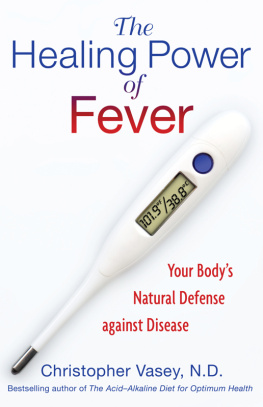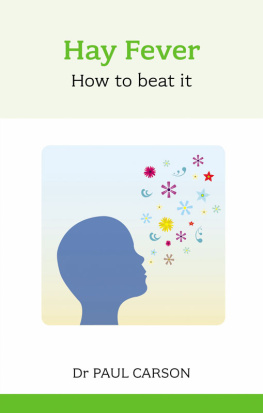Christopher Vasey - The healing power of fever: your bodys natural defense against disease
Here you can read online Christopher Vasey - The healing power of fever: your bodys natural defense against disease full text of the book (entire story) in english for free. Download pdf and epub, get meaning, cover and reviews about this ebook. City: Rochester;Vt, year: 2012;2011, publisher: Inner Traditions;Bear & Company;Healing Arts Press, genre: Romance novel. Description of the work, (preface) as well as reviews are available. Best literature library LitArk.com created for fans of good reading and offers a wide selection of genres:
Romance novel
Science fiction
Adventure
Detective
Science
History
Home and family
Prose
Art
Politics
Computer
Non-fiction
Religion
Business
Children
Humor
Choose a favorite category and find really read worthwhile books. Enjoy immersion in the world of imagination, feel the emotions of the characters or learn something new for yourself, make an fascinating discovery.
- Book:The healing power of fever: your bodys natural defense against disease
- Author:
- Publisher:Inner Traditions;Bear & Company;Healing Arts Press
- Genre:
- Year:2012;2011
- City:Rochester;Vt
- Rating:3 / 5
- Favourites:Add to favourites
- Your mark:
- 60
- 1
- 2
- 3
- 4
- 5
The healing power of fever: your bodys natural defense against disease: summary, description and annotation
We offer to read an annotation, description, summary or preface (depends on what the author of the book "The healing power of fever: your bodys natural defense against disease" wrote himself). If you haven't found the necessary information about the book — write in the comments, we will try to find it.
The healing power of fever: your bodys natural defense against disease — read online for free the complete book (whole text) full work
Below is the text of the book, divided by pages. System saving the place of the last page read, allows you to conveniently read the book "The healing power of fever: your bodys natural defense against disease" online for free, without having to search again every time where you left off. Put a bookmark, and you can go to the page where you finished reading at any time.
Font size:
Interval:
Bookmark:
The
Healing Power
of
Fever
Your Bodys Natural Defense against Disease
Christopher Vasey, N.D.
Translated by Jon E. Graham

Healing Arts Press
Rochester, Vermont Toronto, Canada
Contents
Introduction
As a general rule fever is considered something bad that needs to be fought. In reality it is the result of the effort made by the body to defend itself against an infection or a poison.
Fever is the expression of this protective work. The intensified functioning of the various organ systems involved in the defense response heats up the body, hence the rise in temperature. Striving to eliminate a fever amounts to opposing the bodys natural defense mechanisms; in other words, countering the healing efforts that are implemented as nature intended.
This book explains just what fever is and how to assess its various manifestations and the different stages through which it passes. It also describes how to maintain a fever to achieve true healing and how to control a fever when it becomes too fierce. The techniques provided are simple, natural, and accessible to everyone. They are all based on a commonsense approach and include procedures for treatment based on diet, hydrotherapy, and the use of medicinal herbs.
The majority of fevers are caused by infection. This book will not discuss anti-germ strategies, however. The use of natural antibiotics is a subject in its own right, which I covered in great detail in my book on natural alternatives to antibiotics.
The advice offered in this book for treating a fever should not be regarded as a substitute for the care and follow-up treatment of a trained health professional. Some fevers can conceal dangerous infections that the overeating, stressed out humans of the twenty-first century, whose bodies are weakened by regular exposure to toxins and pollutants, cannot vanquish all on their own. Stronger measures will sometimes be called for. Good common sense should always be used: anything that cannot be easily mastered should be left to the care of a professional.
This book will also describe how to create an artificial fever as a means of treating the body in advance. In other words, we can employ fever as a preventive tool to renew the cellular terrain of the body before the toxins stagnating there can trigger any kind of disease. This book therefore addresses both readers who are sick and seeking care as well as those who are healthy and wish to remain so.
Part One
Understanding Fever


Most people think of fever only as the unpleasant period of time during which the bodys temperature is too high. But to those who understand its different manifestations, fever reveals the intensity with which the body fights against illness. When we understand how this mechanism is working against infection, we can derive useful hints on how to support these efforts. Fever is one of the most powerful defenses of the body. For optimal health, it is essential to have an understanding of its characteristics.
The Temperature of the Human Body
Before studying the characteristics of fever, it is important to first have an understanding of how the body regulates its temperature.
HOMEOTHERMIA
Humans are homeothermic, which means that their body temperature should always remain the same with almost unvarying consistency. In other words, it does not change in accordance with the weather or with atmospheric conditions. Whether it is summer or winter, whether people live in the desert or the far north, their body temperature will always stay around 98.6F. This is the core temperature (inside the body) and not the more superficial reading of 97.7F provided by taking the temperature with a thermometer placed beneath the arm. In the animal kingdom the other homeotherms are mammals such as goats and cows and so forth, as well as birds.
The word homeotherm is used to describe the opposite of the poikilotherm. Poikilothermic animals body temperature varies in accordance with the ambient temperature of their environment. The temperature of these animals will rise when the sun is shining and the weather is hot, such as during the summer, for example, and will fall when it is cloudy, during the night, and during the cold seasons of the year.
One well known example can be used to illustrate these variations of body temperature in response to climatic condition: the lizard. When stretched over a stone, basking in the sun, its body temperature can rise higher than 104F. During colder periods of the year, the lizards temperature can fall to 68F, 50F, or even 41F, depending on the temperature of its environment. Given that the speed of its metabolism is dependent on its internal heat, in summer the lizard can flee with lightning speed, but when the weather turns cold it moves so slowly that it can be trapped without any difficulty.
Some animals, such as hibernating mammals, combine both systems: they are homeotherms in the spring and summer, but with the arrival of winter they fall into the slumber of hibernation and their body temperature matches that of their environment.
It was once common to make a distinction between warm-blooded and cold-blooded animals, but this terminology has been abandoned since the lizard, for example, theoretically a cold-blooded animal, can have a body temperature much higher than we humans who are technically warm-blooded beings!
The fact that they are capable of producing the heat necessary to maintain a consistent body temperature gives homeothermstherefore human beingsa remarkable kind of freedom and independence. No matter what the conditions outside might be, homeothermic beings are able to move about, take care of their daily business, and defend themselves against danger.
While there are numerous advantages to being a homeotherm, there are also several drawbacks. First and foremost, homeotherms can tolerate only minimal variations in body temperature. At several degrees higher than the norm, up to 109.4F to be exact, the mechanisms sustaining life in the body will be destroyed thus bringing on death. When the core temperature drops several degrees below the norm, to 86F, in fact, vital functions will be paralyzed, also causing death.
HEAT IS NECESSARY FOR LIFE
The ideal temperature for the functioning of the human body is 98.6F. This is the temperature required for the enzymes to diligently perform all the biochemical transformations necessary to organic life. Just like the chemist in the laboratory will heat the test tube when trying to combine two substances that are non-miscible in the ambient conditions, the body needs a certain degree of heat in order to function. Countless chemical substances need to be transformed, combined, separated, and recycled in the body for energy production to take place, as well as the building and repair of tissue, respiration, digestion, and so forth. The temperature of 98.6F is also necessary for the organs to function at their optimum levels. Thanks to heat, our bodies are able to function, and, by functioning, our bodies produce the heat that helps them perform all their activities.
Because our body temperature is always stable, and without any effort required on our behalf to consciously maintain it, we often do not realize just how important it is. Yet heat is always associated with life and the living and cold is forever associated with death. A certain internal heat is essential for our survival.
Next pageFont size:
Interval:
Bookmark:
Similar books «The healing power of fever: your bodys natural defense against disease»
Look at similar books to The healing power of fever: your bodys natural defense against disease. We have selected literature similar in name and meaning in the hope of providing readers with more options to find new, interesting, not yet read works.
Discussion, reviews of the book The healing power of fever: your bodys natural defense against disease and just readers' own opinions. Leave your comments, write what you think about the work, its meaning or the main characters. Specify what exactly you liked and what you didn't like, and why you think so.






